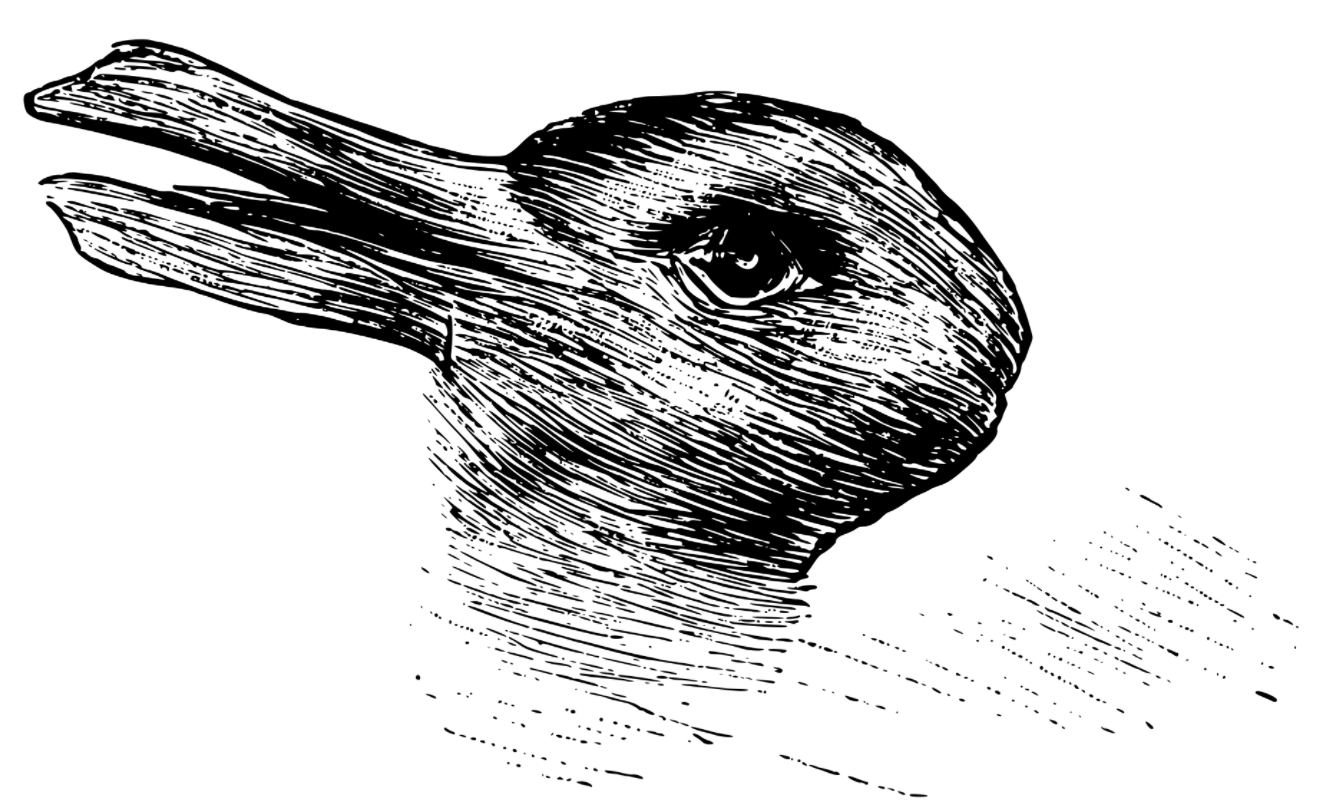Can a duck ever be a rabbit? Wittgenstein and the philosophy of “aspect perception”

- The duck/rabbit image is one of the most famous in philosophy, and it highlights a curious phenomenon called “aspect perception.”
- The philosopher Wittgenstein argued that objects often do not simply appear to our senses, but are “seen as” something. They arrive meaningfully in our understanding.
- Some people might be blind to certain aspects. All of us are certainly ignorant of many aspects within our perception.
Things are rarely simple. It’s often not clear at all what something is, and even when you think you know, things can change in an instant.
Consider the famous image above: Is it a duck or a rabbit? It can’t be both, because a duck cannot be a rabbit. But is it true to say it’s neither? No, it’s either a duck or a rabbit, and the answer changes depending on you. The object itself is fixed. Go away for a cup of tea and the image will be exactly the same. But something in your understanding or perception is shifting the object between duck and rabbit and back again. We cannot say it is definitively a duck or a rabbit. To different people and in different moments, it’s either.
This consideration of “aspect perception” was something that concerned the philosopher Ludwig Wittgenstein, and it raises serious questions about the nature of reality and perception.
Seeing as
In his work, Philosophical Investigations, Wittgenstein draws a distinction between two types of seeing.
First, we have the standard and direct act of seeing — interpreting the stuff that is broken down into sense data for the eyes. For example, you can see the light from your phone, the green on a tree, or the roundness of a table. But we also have the ability to “notice an aspect,” which is where we see an object as a certain kind of object. It means to have the same sensation, but to see it in a different way. To the untrained eye, a blueprint schematic might be mere geometric, maze-like squiggles. But to an engineer, it is “seen as” a blueprint. The engineer notices an aspect that others do not.
Let us suppose that two people come across an abacus. It might be that someone who doesn’t know what an abacus assumes it’s some kind of toy or a strange ornament. You, though, will see an abacus. In this instance, you’re “seeing as,” which means that you see the object as a tool to be used in a certain way.
But this ability to notice aspects can also shift and morph. In an example that Wittgenstein uses, consider the following dots:
• • • •
They can either be viewed as a whole — four dots in a group — or perhaps they might be seen as two dots in the middle, framed by dots on either side. The image remains the same, but our shift in perception is to “notice an aspect.”
A readymade world
We approach the world with concepts and everything we see is filtered by those concepts. Often what we’re told by others or what we learn in life will redefine how we see objects and even people. As Wittgenstein wrote, “I observe a face, and then suddenly notice its likeness to another. I see that it has not changed; and yet I see it differently. I call this experience ‘noticing an aspect’.”
It happens often in life. Imagine a friend or partner says, “have you noticed that your dad looks just like Colonel Sanders?” or “I’ve always thought Elijah Woods looks like Daniel Radcliffe.” After this happens, you can’t stop seeing that person “as” the lookalike. Your perception has shifted, and you will forever snigger whenever you pass a KFC.
The odd moment comes, as in the duck-rabbit image, when you have two competing and equally viable perceptions of the object. You can spend minutes shifting your perception between both. The same is true for the Necker cube — you can make it pop in or out depending on how you want to see it.
But Wittgenstein’s point is that these moments of being conscious of an objects transitive ambiguity are exceedingly rare. Objects usually have an immediacy to them, or a readymade understanding.
It’s not that we see an object and then “interpret” it as either a duck or rabbit. We don’t spend hours and all our mental energy rotating or twisting objects to then file against a gigantic catalogue of concepts to determine whether it’s a certain thing or not. Instead, perceptions directly and instantly come to us as a duck or a rabbit. Our concepts frame our perceptions on the spot.
Aspect blindness
A curious feature of this is what Wittgenstein calls “aspect blindness.” This is where a person is incapable of seeing an object a certain way at all. It’s impossible to be entirely aspect blind, because we always have at least one way of seeing that object — even if you that’s just raw visual data.
But suppose, for instance, that some people simply cannot see an actor or a picture as standing for something else. What if you go to watch a play and are utterly unable of seeing that prancing, costumed actor as being Puck, the mischievous fairy? What if you can’t see the old woman in the classic old-young woman illusion? What if ¯\_(ツ)_/¯ does not appear as an emoji, but only a random, assemblage of nonsense punctuation? According to Wittgenstein, we should call these people “aspect blind.” Be it the distractions of their environment, a lack of prior learning, or simply some unknown psychological factor, but some people simply cannot see one thing as something else.
We are all, if not aspect blind, definitely aspect ignorant to some degree. It might be that objects we assume are one thing actually have a host of hidden aspects waiting to be seen. Maybe tomorrow a toddler will point out your car’s lights look like a face, or you’ll read an article highlighting hidden images in logos. The previous way of seeing things becomes changed.
Wittgenstein’s examination of the duck-rabbit image reveals to us the power of our learning and induction into our world’s rules. When your teacher says, “this is an abacus” or your parents say, “that’s a rhino”, they are entering your head to irrevocably and magnificently transform how you see the world.
Jonny Thomson teaches philosophy in Oxford. He runs a popular Instagram account called Mini Philosophy (@philosophyminis). His first book is Mini Philosophy: A Small Book of Big Ideas.





